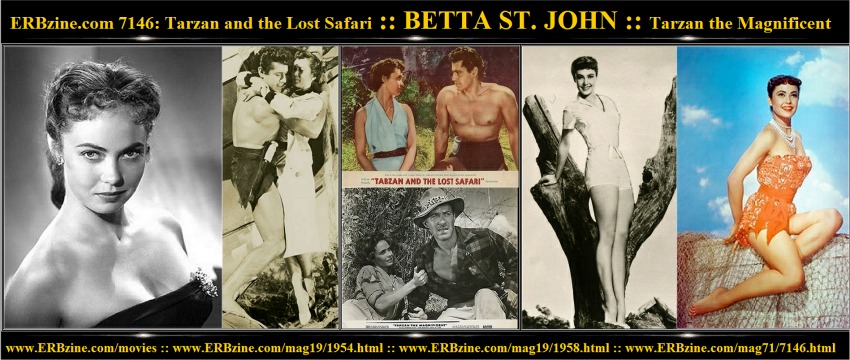
Official Edgar Rice Burroughs Tribute and Weekly Webzine Site Since 1996 ~ Over 15,000 Web Pages in Archive Volume 7146 Spotlight On BETTA ST. JOHN by Robert Allen Lupton |

Official Edgar Rice Burroughs Tribute and Weekly Webzine Site Since 1996 ~ Over 15,000 Web Pages in Archive Volume 7146 Spotlight On BETTA ST. JOHN by Robert Allen Lupton |
Betta St. John (born Betty Jean Striegler on November 26, 1929) is an American actress, singer and dancer. She was born in Hawthorne, California. St. John was part of the Meglin Kiddies troupe as a youngster. Betta made her film debut at age 10 with an unbilled role of a little girl who sang Marlene Dietrich's song "Little Joe" in the classic western “Destry Rides Again” (1939) starring Marlene Dietrich and James Stewart. She went on to also appear in an Our Gang short and had unbilled orphan roles in both “Jane Eyre” (1943) and “Lydia” (1941).
Betta appeared in two Tarzan films, She played Diane Penrod in “Tarzan and the Lost Safari,” and Fae Ames in “Tarzan the Magnificent.” Jane did not appear in either film.
The musical team of Richard Rodgers and Oscar Hammerstein took notice of this young, attractive singing/dancing talent and cast her in Broadway's "Carousel" in 1945. Four years later, when they were ready to cast the exotic role of "Liat" for their upcoming musical "South Pacific" starring Mary Martin and Ezio Pinza, and they selected the beautiful Betta St. John.
The Broadway show was a blockbuster. While performing in the show's London tour at the Theatre Royale Drury Lane Theatre early in 1952, she met and worked with British opera singer and cast member Peter Grant (he played Lt. Cable). They married on November 27th of that year and remained married until his death in 1992.
The musical splash Betta made on Broadway, reopened the door for some decorative film work. She made her adult debut in the second femme lead (behind Deborah Kerr) in “Dream Wife” (1953). She played Tarji, a princess, who is courted by bachelor tycoon Cary Grant.
This led to other "B"-level co-star/featured parts in a number of exotic eastern and western adventures throughout the 1950's including Miriam in the biblical epic “The Robe” (1953).
Lady Iolanthe opposite Ricardo Montalban in “The Saracen Blade” (1954).

She played Princess Johanna in “The Student Prince” (1954) and outlaw Billy the Kid's (played by Scott Brady) love interest in “The Law vs. Billy the Kid” (1954).
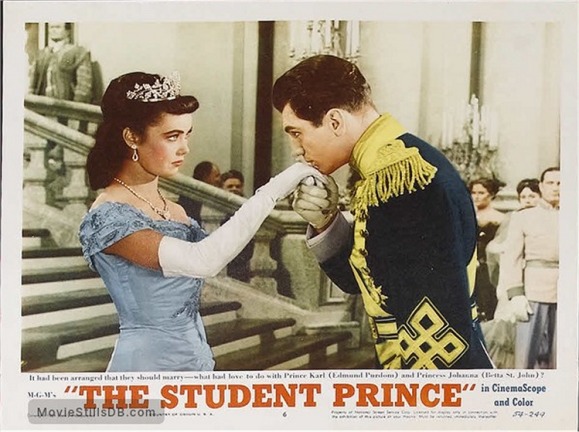
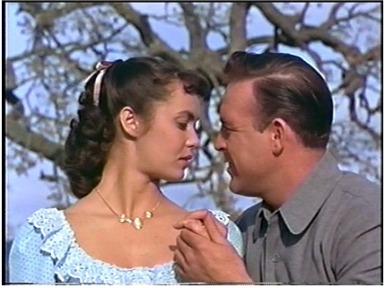
She played a British belle in the mystery drama “Alias John Preston” (1955) which had a small featured role for husband Peter Grant; and a Canadian islander (she is top-billed) in the British-made “High Tide at Noon” (1957).
After numerous guest appearances on TV here and in England, Betta co-starred with Boris Karloff and Christopher Lee in the British-made “Horror Hotel,” and Lee again in “The City of the Dead” (1960), and made one last movie excursion into the jungle with Gordon Scott's in “Tarzan the Magnificent” (1960) before abandoning the limelight altogether.
She’s one of the few actresses to appear in more than one Tarzan film playing different roles, Fae Ames in “Tarzan the Magnificent” and Diane Penrod in “Tarzan in the Lost Safari.” She shared the screen with two Tarzans, Gordon Scott and Jock Mahoney, although Mahoney didn’t play Tarzan in Magnificent, he played the bad guy, Coy Banton.


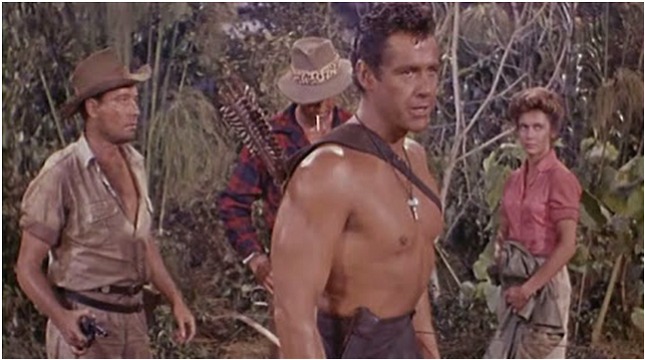
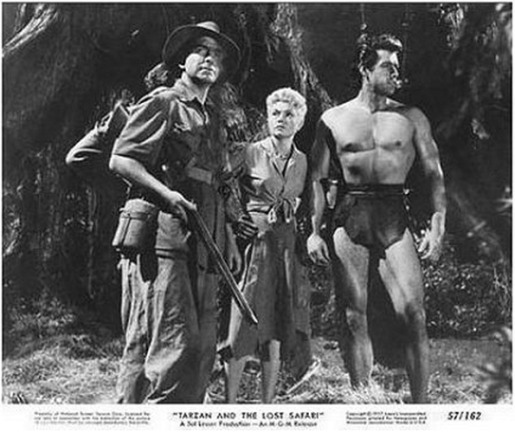
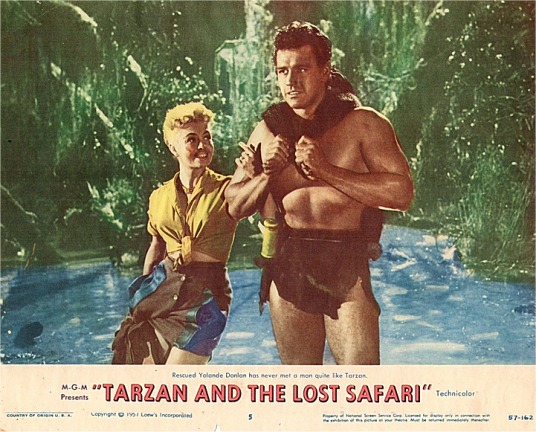


What follows is the text of an interview with Betta St. John that appears on the website, www.filmsofthefifties.com. The interviewer is not identified, nor is the date of the interview. It repeats some of the information previously mentioned in this article. She didn’t think much of Gordon Scott’s acting ability, but his career lasted longer than hers. The interview begins here:Betta St. John played the second lead role in 1953’s “Dangerous Mission” with Victor Mature, Vincent Price and Piper Laurie.
Whether singing Marlene Dietrich’s song “Little Joe” in “Destry Rides Again” or swimming with Tarzan, actress Betta St. John savored life in the Hollywood jungle.
A long-time resident of Banning, Betta St. John was born Betty Striegler in Hawthorne, California, on Nov. 26, 1929. She started in movies as a background player in the late 1930s and early 1940s using her real name.
“Betta, how did you get into acting?”
“Those were the days of Shirley Temple. Many mothers sent their daughters to dancing school. At age 7, I started with theatrical schools on Saturday – dancing, singing, and all the bits you do at an early age. If the studios needed children, they contacted the theatrical schools.”
“I was seven or eight when I got my first background part receiving my social security number at age 8!
“The nearest I came to playing a substantial part as a child was in the classic western “Destry Rides Again” in 1939 with Marlene Dietrich.
“I’ll never forget that day because I was taken to meet her for her approval and I was extremely nervous. She was wearing her dance hall outfit and had gold glitter in her hair. My eyes nearly popped out when I saw her; I’d never seen anyone dressed like that and as a ten-year-old I thought she was simply marvelous!”
That same year St. John was offered a role in the movie The Wizard of Oz but her parents turned it down.
“How were you cast in “Destry Rides Again”?”
“The sequence is near the film’s end, where you see me sitting in the back of a moving wagon reprising Dietrich’s “Little Joe” number. That was the only time I’ve ever sung full-strength with my own voice and no inhibitions.”
“I can’t imagine landing a role like that at ten years old! You must have had a wonderful voice.”
“Oh, I loved every moment of it. It was much more fun than school!”
In 1944, St. John appeared in an Our Gang short and in Jane Eyre in an unbilled role.
Rodgers and Hammerstein took notice of this young, attractive singing and dancing talent and cast her in a role in Carousel in 1945. She played Louise, the daughter of the principal players. When the musical team was ready to cast the role of Liat for their new musical South Pacific starring Mary Martin and Ezio Pinza in 1949, they had to look no further than the beautiful, exotic-looking Betta.“Tell me about your experience on the New York stage.”
“A couple of years after Destry, things really happened fast. I was contacted by the New York Theater Guild, which already had done stage productions of Rodgers and Hammerstein’s Oklahoma! and Carousel and were working on South Pacific.
The Theater Guild workers came out to the West Coast because they were putting together various companies and needed more actors and actresses. Whatever I did obviously impressed them enough, because they came straight back and asked if I would go to New York, where they would put me into either Oklahoma! or Carousel, whichever one opened first.
“There I was, a sophomore in high school, faced with the choice of ‘Do you want to go back to school, or do you want to go to New York?’ In New York a whole new world opened up for me – a world I didn’t even know existed. You have to understand that I came from an un-sophisticated family and was so wet behind the ears! Later on I was cast in South Pacific playing Liat, one of the principal roles.”
“How long did you perform in Carousel and South Pacific?”
“Appearing on Broadway was a major step in my career and I was only 16 when I made my debut in New York. As you know, both plays were a huge success and lasted for well over a year. After New York, I went to England and appeared in the 1951 West End production of South Pacific.”
“Didn’t you meet your husband in England?”
“Yes, I did. Peter Grant was my leading man in the South Pacific production in London. In 1952, he became my husband.”
“Wasn’t your husband also an opera singer?”
“Yes, he was an opera singer and also sang in musicals. He mostly performed in London, but his company also toured Australia, New Zealand and the United States.”In 1999, St. John, along with the remaining original cast, attended the 50th anniversary of South Pacific in New York. Her husband passed away in 1992 and was unable to attend with her.
St. John’s big splash on the musical stage soon led her back to films.
“What was your first movie role as an adult?”
“In 1953 at the age of 22, I played my first grown-up movie part, a royal Middle Eastern girl, in Dream Wife opposite Gary Grant. When this part came along, my name was still fresh from playing Liat in South Pacific, and the part in that film was very Liat-like. So MGM called me and I was tested in London and brought back to Hollywood.
“Immediately following that, I did a film called All the Brothers Were Valiant, also for MGM, which filmed in Jamaica. That was a lot of fun. In that movie, Stewart Granger, Ann Blyth and Robert Taylor played the leading roles.
“Right on top of those two movies I was cast in The Robe, starring Richard Burton. Richard was a legit actor who felt he was only in Hollywood for the money, but it was a lovely experience working with him. I played a crippled girl in that movie.”
“I understand you worked in both big studio films as well as low-budget films. What was that like?”
“Actually I kind of enjoyed it. It was a faster shooting schedule, and you didn’t get all the pampering and spoiling you did on bigger pictures. It must be what people experience nowadays when making an independent film – much more of a feeling that you’re involved. You understand what the whole thing is about, and you aren’t just a puppet who dances on a string.
“Dream Wife was shot in eight weeks. Going from an 8-week picture to one done in 10 days, suddenly you’re much more under pressure, but I liked it. Being a bigger part of something small was almost more enjoyable than being a smaller part of something big.”“How did you land the part in Tarzan in The Lost Safari?”
“I wasn’t tested for it; I was sent the script because the studio thought I was right for the part.”
“Was the interior jungle set as large and impressive as it appeared on screen?”
“Oh, it was one big set. The whole thing was done on one huge soundstage, including the river scene. There was one shot that was great fun. It was when the crocodile chases me. Of course it wasn’t a real crocodile, but it still made me swim fast!”
“Do you think Gordon Scott was a good Tarzan?”“Physically, yes, but he wasn’t much of an actor. It was an unbelievable character anyway -- don’t you think? He was convincing in the action shots, but I haven’t seen many Tarzans to compare. I enjoyed seeing Greystroke, which was based on a book. But that movie wasn’t anything like the old Tarzan movies.”
“Do you have a favorite movie that you played in?”
“There are two favorites. I enjoyed playing Princess Johanna in “The Student Prince.” It was always a thrill to work with professional actors such as Ann Blyth and Edmond Purdom who played the prince. Another favorite was “High Tide at Noon” set on an island in Nova Scotia. The movie was based on a book by the same name.”“In The Student Prince wasn’t Mario Lanza supposed to play the prince?” 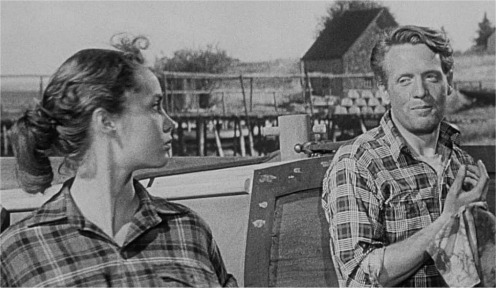
“Yes he was, but he had a dispute with the studio and didn’t get the role, however, they did use his voice.”
“So how long was your acting career and why did you decide leave the business?”
“I thought my career was long enough (1953 to the early ’60s) and I didn’t feel I was giving up very much at that point. But I gave it up mainly because I wanted to stay home and raise the children and my family was much more important to me.”
“Very few actors, even if they’re extremely successful, can keep a family and marriage together, with a good career going, too. By that time I had come to terms that I didn’t have the kind of acting ability that would keep on going forever.
“My last film, Horror Hotel, was sort of an embarrassment because I didn’t like horror movies. But I’m glad I did it because apparently it’s a cult film, and very good in its way.”
“How did you happen to end up in Banning of all places?”
“Well, my parents had a cabin in the Morongo Valley and we enjoyed our visits there. After my father passed away, we decided to move here to be near my mother. I’ve lived in Banning over 30 years and my children were raised here. After my husband died in ’92, I decided to stay in the area because I liked it here and I still have my home in London as well.”
“You’ve very fit, what do you do to stay in such great shape?”
“I practice yoga regularly and I attend Tai Chi classes in Yucaipa. I also like to hike; there’s so many great hiking trails in this area.”
“Do your children still live in this area?”
“No. My son is a television producer and lives in London. My daughter Deanna lives in Seattle and my other daughter Karen now lives in Utah. When Karen lived here, she did some acting and was involved with the local theater. For four seasons she played the lead role in the play Ramona that’s performed in Hemet every year.”
Betta St. John appeared in 38 films and a number of television productions. She has homes in Banning and England. In the summer she travels back to the U.K., where she enjoys activities like hiking the cliffs of Dorset.
